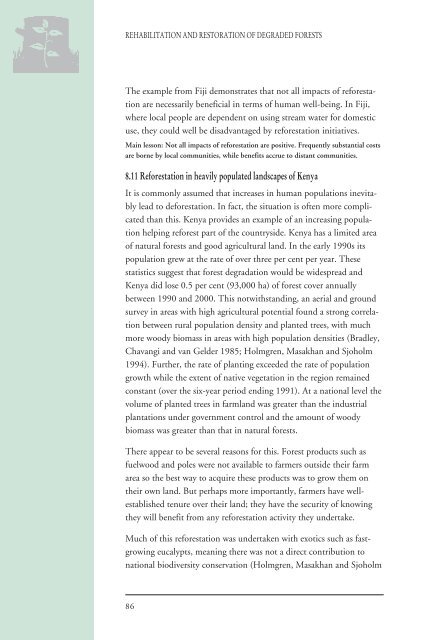Rehabilitation and Restoration Of Degraded Forests (PDF) - IUCN
Rehabilitation and Restoration Of Degraded Forests (PDF) - IUCN
Rehabilitation and Restoration Of Degraded Forests (PDF) - IUCN
You also want an ePaper? Increase the reach of your titles
YUMPU automatically turns print PDFs into web optimized ePapers that Google loves.
REHABILITATION AND RESTORATION OF DEGRADED FORESTS<br />
The example from Fiji demonstrates that not all impacts of reforestation<br />
are necessarily beneficial in terms of human well-being. In Fiji,<br />
where local people are dependent on using stream water for domestic<br />
use, they could well be disadvantaged by reforestation initiatives.<br />
Main lesson: Not all impacts of reforestation are positive. Frequently substantial costs<br />
are borne by local communities, while benefits accrue to distant communities.<br />
8.11 Reforestation in heavily populated l<strong>and</strong>scapes of Kenya<br />
It is commonly assumed that increases in human populations inevitably<br />
lead to deforestation. In fact, the situation is often more complicated<br />
than this. Kenya provides an example of an increasing population<br />
helping reforest part of the countryside. Kenya has a limited area<br />
of natural forests <strong>and</strong> good agricultural l<strong>and</strong>. In the early 1990s its<br />
population grew at the rate of over three per cent per year. These<br />
statistics suggest that forest degradation would be widespread <strong>and</strong><br />
Kenya did lose 0.5 per cent (93,000 ha) of forest cover annually<br />
between 1990 <strong>and</strong> 2000. This notwithst<strong>and</strong>ing, an aerial <strong>and</strong> ground<br />
survey in areas with high agricultural potential found a strong correlation<br />
between rural population density <strong>and</strong> planted trees, with much<br />
more woody biomass in areas with high population densities (Bradley,<br />
Chavangi <strong>and</strong> van Gelder 1985; Holmgren, Masakhan <strong>and</strong> Sjoholm<br />
1994). Further, the rate of planting exceeded the rate of population<br />
growth while the extent of native vegetation in the region remained<br />
constant (over the six-year period ending 1991). At a national level the<br />
volume of planted trees in farml<strong>and</strong> was greater than the industrial<br />
plantations under government control <strong>and</strong> the amount of woody<br />
biomass was greater than that in natural forests.<br />
There appear to be several reasons for this. Forest products such as<br />
fuelwood <strong>and</strong> poles were not available to farmers outside their farm<br />
area so the best way to acquire these products was to grow them on<br />
their own l<strong>and</strong>. But perhaps more importantly, farmers have wellestablished<br />
tenure over their l<strong>and</strong>; they have the security of knowing<br />
they will benefit from any reforestation activity they undertake.<br />
Much of this reforestation was undertaken with exotics such as fastgrowing<br />
eucalypts, meaning there was not a direct contribution to<br />
national biodiversity conservation (Holmgren, Masakhan <strong>and</strong> Sjoholm<br />
86

















